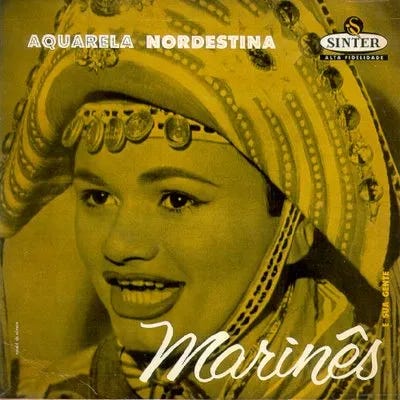EVERY GENRE PROJECT - May 9 - Xaxado
Genre of the Day - Xaxado 🇧🇷
Album of the Day - Aquarela Nordestina by Marinês (1959)
May 9, 2024
Butch Cassidy. Robin Hood. We adore stories of bandits in society, those who live on their own terms, beyond the law. Maybe we forget to scan a drink at the self-checkout here or there to emulate them. (I do not endorse! But yum!) Brazil has its own bandit lore, a history that was much more of an epidemic than in the United States. The Brazilian banditry boom developed in the late 1800s and peaked in the 1920s and ‘30s as increasing amounts of people in the nation’s northeast hopped off the grid to form social bandit groups. The phenomenon was called cangaço, and they appear in Brazilian art with their own music genre. Today’s genre makes it evident that fascination with bandits and pirates, and a slightly warped urge within all of us to root for them against the powers that be, pervades across the world.
A fearsomely-mononymed man named Lampião was Brazil’s banditry, or cangaço, figurehead. He grew up in the rough, rural, arid and poor backlands of the state Pernambuco, where police violence was endemic in the context of reprimanding the workers of the latifundio landed estates. Militaristic police repression never really abated through the 20th century: one particularly bloody massacre of landless agrarian workers 17 April 1996 is now celebrated as the International Day of Struggle for Agrarian Reform.
Banditry is a form of radicalization. A desperation for land, food, or resources leads to an attractive option in flouting the law and risking your life as a fugitive. Lampião and his mates had the hands to do it: he acquired his nickname, which means lamp-holder in Portuguese, due to how fast he could shoot, his gun’s flares resembling a constant lamp. His legacy is hardly akin to Robin Hood. It’s certainly not characterized by generosity. He and his goons created the blueprint for today’s drug cartels notorious in Brazil for kidnapping, extortion, and bloody murders as collateral damage to civilians. Despite this, it’s still glamorized by many, and he and his partner Maria Bonita remain folk heroes.
Music inspired by the alluring power of gangsters has a lengthy history prior to the explosion of gangster rap’s popularity in the 1990s. In Brazil, it’s xaxado. Xaxado is actually rooted in the traditions of the bandits themselves. Everybody loves to celebrate a win, and with each successful heist or successful violent campaign, initially only the men danced and sang in a call-and-response fashion, brandishing rifles in their performance. Maria Bonita broke the gender barrier in xaxado, and the music gradually grew in popularity as a genre in the northeast that wasn't exclusively performed by cangaceiros themselves, but as an homage to their defiance and resistance among marginalized communities of the poorer northeast. The music makes frequent instrumental use of the sound of the dancer’s feet meant to evoke the bandits’ sandals striking the earth, the zabumba drum, the accordion, and the triangle. Adding another unique flair is the rhythm’s emphasis on the third offbeat, creating a distinctive rhythm—maybe to warn you of their approach, maybe as a subtle act of musical rebelling to really hammer the outlaw aspect home.
The first track advertises the grandeur of the dance of xaxado and Marinês waits no time to inform you that she is its queen. In her voice, she seizes the confidence people like Lampião surely wielded. The accordion manages to sound dark and stormy, a first over my course of hearing the instrument frequently over this column, but it retains its theatricality. I couldn’t decipher the lyrics of “Pisa na Fulo”—different translator platforms even seemed to struggle with certain words—but note the characteristic use in xaxado of frequently repeated choruses. It’s fun for the whole bandit family. Marinês sounds much sweeter than you’d expect from a gangster-emulating singer, with a similarly light, feminine voice to, say, Rosalía, but her ability to power over the rhythmic hooplah of a song like “Saudade de Campina Grande” is a testament to her status as the queen as she extolls the city of Campina Grande. Their hats may be beautiful, and so is their music, but maintaining a healthy fear of the cangaceiros is probably wise.
PS. Can Brazilian banditry lore take Brazilian buttlift’s place as the acronym BBL?





